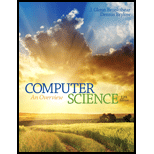
Computer Science: An Overview (12th Edition)
12th Edition
ISBN: 9780133760064
Author: Glenn Brookshear, Dennis Brylow
Publisher: PEARSON
expand_more
expand_more
format_list_bulleted
Textbook Question
Chapter 7, Problem 40CRP
Identify some design patterns in fields other than software engineering.
Expert Solution & Answer
Want to see the full answer?
Check out a sample textbook solution
Students have asked these similar questions
I need to define and discuss the uses of one monitoring or troubleshooting tool in Windows Server 2019. thank you
I would likr toget help with the following concepts:
- Windows Server features
- Windows Server versus Windows 10 used as a client-server network
I need to define and discuss the uses of one monitoring or troubleshooting tool in Windows Server 2019. thank you
Chapter 7 Solutions
Computer Science: An Overview (12th Edition)
Ch. 7.1 - Prob. 1QECh. 7.1 - Prob. 2QECh. 7.1 - Prob. 3QECh. 7.1 - Identify two contexts in which the field of...Ch. 7.2 - Prob. 1QECh. 7.2 - Prob. 2QECh. 7.2 - What is the role of a software requirements...Ch. 7.3 - Prob. 1QECh. 7.3 - Prob. 2QECh. 7.3 - Prob. 3QE
Ch. 7.3 - What potential problems do you suspect could arise...Ch. 7.4 - Prob. 1QECh. 7.4 - Prob. 2QECh. 7.4 - Prob. 3QECh. 7.4 - Prob. 4QECh. 7.4 - Prob. 5QECh. 7.4 - What is the difference between a traditional...Ch. 7.4 - Prob. 8QECh. 7.5 - Prob. 1QECh. 7.5 - Prob. 2QECh. 7.5 - Prob. 3QECh. 7.5 - Prob. 4QECh. 7.5 - Prob. 6QECh. 7.6 - Prob. 1QECh. 7.6 - Prob. 2QECh. 7.6 - Prob. 3QECh. 7.6 - Prob. 4QECh. 7.6 - Prob. 5QECh. 7.6 - Prob. 6QECh. 7.7 - Prob. 1QECh. 7.7 - Prob. 2QECh. 7.7 - Prob. 3QECh. 7.8 - Prob. 1QECh. 7.8 - Prob. 2QECh. 7.8 - Prob. 3QECh. 7.8 - Prob. 4QECh. 7.9 - Prob. 1QECh. 7.9 - Prob. 2QECh. 7.9 - Prob. 3QECh. 7 - Give an example of how efforts in the development...Ch. 7 - Prob. 2CRPCh. 7 - Explain how the lack of metrics for measuring...Ch. 7 - Would you expect that a metric for measuring the...Ch. 7 - Prob. 5CRPCh. 7 - Prob. 6CRPCh. 7 - Prob. 7CRPCh. 7 - Prob. 8CRPCh. 7 - Prob. 9CRPCh. 7 - Prob. 10CRPCh. 7 - Prob. 11CRPCh. 7 - Prob. 13CRPCh. 7 - Prob. 14CRPCh. 7 - Prob. 15CRPCh. 7 - Prob. 16CRPCh. 7 - Prob. 17CRPCh. 7 - Prob. 18CRPCh. 7 - Prob. 20CRPCh. 7 - Prob. 21CRPCh. 7 - Prob. 22CRPCh. 7 - Prob. 23CRPCh. 7 - Prob. 24CRPCh. 7 - Contrast the information represented in a class...Ch. 7 - What is the difference between a one-to-many...Ch. 7 - Prob. 27CRPCh. 7 - Prob. 28CRPCh. 7 - Prob. 29CRPCh. 7 - Prob. 30CRPCh. 7 - Prob. 31CRPCh. 7 - Prob. 32CRPCh. 7 - Prob. 33CRPCh. 7 - Prob. 34CRPCh. 7 - Extend your solution to the previous problem to...Ch. 7 - Prob. 38CRPCh. 7 - Prob. 39CRPCh. 7 - Identify some design patterns in fields other than...Ch. 7 - Prob. 41CRPCh. 7 - Prob. 42CRPCh. 7 - Prob. 43CRPCh. 7 - Prob. 44CRPCh. 7 - Prob. 45CRPCh. 7 - Prob. 46CRPCh. 7 - How does open-source development differ from beta...Ch. 7 - Prob. 48CRPCh. 7 - Prob. 49CRPCh. 7 - Prob. 50CRPCh. 7 - Prob. 51CRPCh. 7 - Prob. 52CRPCh. 7 - In what ways can a software developer be...Ch. 7 - Prob. 1SICh. 7 - Prob. 2SICh. 7 - Prob. 3SICh. 7 - Prob. 4SICh. 7 - Prob. 5SICh. 7 - What happens if technology begins to advance so...Ch. 7 - Is the computer revolution contributing to, or...Ch. 7 - Prob. 8SICh. 7 - If you had a time machine, in which period of...Ch. 7 - Prob. 10SI
Knowledge Booster
Learn more about
Need a deep-dive on the concept behind this application? Look no further. Learn more about this topic, computer-science and related others by exploring similar questions and additional content below.Similar questions
- Please solve and answer the questions correctly please. Thank you!!arrow_forwardConsidering the TM example of binary sum ( see attached)do the step-by-step of execution for the binary numbers 1101 and 11. Feel free to use the Formal Language Editor Tool to execute it; Write it down the current state of the tape (including the head position) and indicate the current state of the TM at each step.arrow_forwardI need help on inculding additonal code where I can can do the opposite code of MatLab, where the function of t that I enter becomes the result of F(t), in other words, turning the time-domain f(t) into the frequency-domain function F(s):arrow_forward
arrow_back_ios
SEE MORE QUESTIONS
arrow_forward_ios
Recommended textbooks for you
 Fundamentals of Information SystemsComputer ScienceISBN:9781337097536Author:Ralph Stair, George ReynoldsPublisher:Cengage Learning
Fundamentals of Information SystemsComputer ScienceISBN:9781337097536Author:Ralph Stair, George ReynoldsPublisher:Cengage Learning Systems ArchitectureComputer ScienceISBN:9781305080195Author:Stephen D. BurdPublisher:Cengage Learning
Systems ArchitectureComputer ScienceISBN:9781305080195Author:Stephen D. BurdPublisher:Cengage Learning Principles of Information Systems (MindTap Course...Computer ScienceISBN:9781285867168Author:Ralph Stair, George ReynoldsPublisher:Cengage Learning
Principles of Information Systems (MindTap Course...Computer ScienceISBN:9781285867168Author:Ralph Stair, George ReynoldsPublisher:Cengage Learning Enhanced Discovering Computers 2017 (Shelly Cashm...Computer ScienceISBN:9781305657458Author:Misty E. Vermaat, Susan L. Sebok, Steven M. Freund, Mark Frydenberg, Jennifer T. CampbellPublisher:Cengage Learning
Enhanced Discovering Computers 2017 (Shelly Cashm...Computer ScienceISBN:9781305657458Author:Misty E. Vermaat, Susan L. Sebok, Steven M. Freund, Mark Frydenberg, Jennifer T. CampbellPublisher:Cengage Learning Principles of Information Systems (MindTap Course...Computer ScienceISBN:9781305971776Author:Ralph Stair, George ReynoldsPublisher:Cengage Learning
Principles of Information Systems (MindTap Course...Computer ScienceISBN:9781305971776Author:Ralph Stair, George ReynoldsPublisher:Cengage Learning

Fundamentals of Information Systems
Computer Science
ISBN:9781337097536
Author:Ralph Stair, George Reynolds
Publisher:Cengage Learning

Systems Architecture
Computer Science
ISBN:9781305080195
Author:Stephen D. Burd
Publisher:Cengage Learning

Principles of Information Systems (MindTap Course...
Computer Science
ISBN:9781285867168
Author:Ralph Stair, George Reynolds
Publisher:Cengage Learning

Enhanced Discovering Computers 2017 (Shelly Cashm...
Computer Science
ISBN:9781305657458
Author:Misty E. Vermaat, Susan L. Sebok, Steven M. Freund, Mark Frydenberg, Jennifer T. Campbell
Publisher:Cengage Learning

Principles of Information Systems (MindTap Course...
Computer Science
ISBN:9781305971776
Author:Ralph Stair, George Reynolds
Publisher:Cengage Learning

9.1.2 Software Development Approaches; Author: EIToppo;https://www.youtube.com/watch?v=Z9znuSQ7Sz8;License: Standard YouTube License, CC-BY